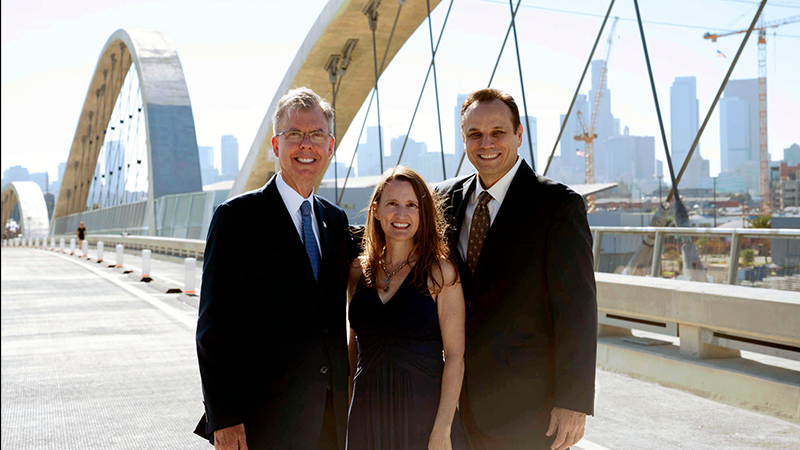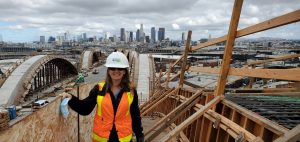Bridging the Gap: How Julie Allen ’92 Brought LA’s Sixth Street Viaduct to Life

From left: Gary Lee Moore, Julie Allen and Ted Allen at the Sixth Street Viaduct grand opening
On July 10, Los Angeles’ rebuilt Sixth Street Bridge opened to the public, establishing itself as a new monument on the city’s landscape that connects downtown’s Arts District with LA’s Eastside over the Los Angeles River.
As pedestrians, cyclists and skateboarders made their way along the bridge, enjoying the unparalleled view of the LA skyline, few of them likely knew that one of the people they had to thank for the new stretch of road was a Bruin engineer.
Julie Allen, who graduated with a bachelor’s degree in civil and environmental engineering in 1992, was the project manager for the Sixth Street Viaduct for seven years, working since 2015 as a principal civil engineer at the Los Angeles Department of Public Works (LADPW) Bureau of Engineering to bring the $588 million bridge to life.
Before putting her skills to use to create a new crown jewel for the city, Allen was a young student with a love of learning. Growing up in Modesto in California’s Central Valley, she spent her days on the debate team and in mock trial competitions and academic decathlons. She also developed a passion for engineering drawing, also known as drafting, and architecture.
When it came time to look for a college program that would combine her many passions, Allen chose civil engineering.
“I decided that civil engineering would be a great major to merge my interest in structures and my aptitude in math, and it would still leave me the option to go to law school if I didn’t enjoy engineering,” said Allen, who is now Assistant Director in the LADPW’s Bureau of Sanitation. “I found that UCLA was not only an outstanding engineering school but also had so much to offer outside of the classroom.”
While at UCLA, Allen’s drive and ambition continued to grow. She had two engineering internships while pursuing her undergraduate degree: one with the LA Department of Water and Power (LADWP) and another with the LA County Sanitation Districts.
After getting her bachelor’s degree, Allen began her career at LADWP in the environmental and government affairs department before joining the city’s Bureau of Engineering.
“It was extremely important that we created a new iconic landmark for the residents since the bridge we were replacing was so cherished by the community,” Julie Allen said.
The bridge design was about 35% complete when Allen began overseeing the complex logistics of funding, expenditures, securing agency approvals, and other technical and environmental considerations to make sure the bridge was structurally and environmentally sound.
The new bridge replaces the original Sixth Street Bridge built in 1932, which was an iconic landmark in its own right — with John Travolta drag racing underneath it in the blockbuster movie “Grease” and countless features in other movies, music videos and car commercials.
Over time, however, the bridge had been slowly breaking down, making it extremely vulnerable if an earthquake were to strike. The bridge’s concrete was mixed using an aggregate source from the Santa Barbara area, which was high in alkali, eventually creating a chemical reaction that caused the concrete to crumble. The new bridge, however, is capable of withstanding a once-in-a-millennium seismic event — about 7.8 magnitude or greater.
Each column of the bridge is on a triple-friction pendulum bearing that is nearly 7 feet in diameter, and the viaduct is a continuous structure, with the expansion joints occurring only at each end of the bridge. This means that, during an earthquake, the structure will move as a single unit while the ground shakes below.
“While I hope the big one doesn’t hit Los Angeles, if you happened to be on the Sixth Street Viaduct, it would be a very safe place to be,” Allen said.
The project required the collaboration of many accomplished engineers, including alumnus Gary Lee Moore ’85 who has a bachelor’s degree in mechanical engineering. As the city engineer, Moore provided executive oversight during the project’s 20-year development process, from the early conceptual design and environmental approvals through final completion.
For Allen, it was important to honor the cultural legacy of the original bridge and create a new place for Angelenos to enjoy their city.

“It was extremely important that we created a new iconic landmark for the residents since the bridge we were replacing was so cherished by the community,” she said. “Our goal is for the bridge to represent Los Angeles and for the residents to take pride in being a part of its history.”
Of the Sixth Street Bridge’s many features, there are a few that are among Allen’s favorites. The signature undulating arches can be lit up in different colors to celebrate holidays and community events, and a helical ramp that provides Americans with Disabilities Act access from the ground to the bridge deck and gives pedestrians a close-up view of the underside of the deck and its beams.
One more unexpected element? Bat houses.
“Since there were bats living in the various gaps in the original viaduct, we were required to install permanent bat houses on the beams and girders of the new bridge,” Allen said. “After completion of the park, you will be able to enter the LA River under the bridge, and if you look up, you can see the concrete bat houses attached to the underside of the bridge.”
While at UCLA, Allen met her future husband, Ted, who also was studying civil engineering — marking the early beginning of what would become a family of engineers, including a few Bruin engineers. Ted Allen was recently appointed city engineer and executive director of LA’s Bureau of Engineering by Mayor Eric Garcetti.
Their son, Noah, just graduated from UC Riverside with a degree in computer engineering while their daughter, Kyra, is a second-year aerospace engineering student at UCLA.
“We are so proud of both of them,” Allen said. “In fact, an entire neighborhood may have overheard my excited yell when Kyra found out she was admitted. Ted and I have both stayed connected to UCLA engineering in various ways, so it is really rewarding to get to share that experience with our daughter.”
Allen’s advice to the next generation of civil engineers is to explore as many specialization areas as possible because you never know what will come next in your career.
“We are so fortunate that UCLA provides such a strong foundation in all areas of civil engineering, so even if you change course mid-career like I did, you can always reach back into your educational background to remember the key skills and knowledge required to succeed,” she said.
Sara Hubbard contributed to this story.
